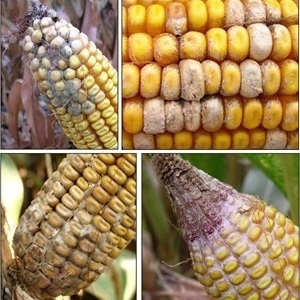DuPont Pioneer warns of potential for corn ear molds this year

DuPont Pioneer
September 26, 2013
BY DuPont Pioneer
A growing season characterized by weather extremes, leading to crop stress during flowering and delayed maturity, has created favorable conditions for classic corn ear molds. DuPont Pioneer experts warn that the environment will become increasingly ideal for ear molds if the weather brings cooler temperatures and periodic rains as we head into harvest. In addition, drought stress and insect injury to the crop provide an avenue for fungi to enter, causing ear molds to establish and spread.
“The carryover of ear mold inoculum from last year’s drought environment is likely minimal; however, growers with a history of molds should carefully scout their fields,” says Bill Dolezal, DuPont Pioneer plant pathology research fellow. “While not significant, we have heard reports of ear molds in Indiana and Illinois, as well as Missouri and Tennessee, this year. Ear molds reduce yield potential, grain quality and feed value.”
While scouting, it is important to identify molds and determine if mycotoxins are present. If mold presence is greater than 10,000 cfu/gram and is of the Aspergillus, Fusarium, Gibberella or Penicillium strains, a mycotoxin screening should be completed. Many crop insurance policies require that you contact your crop insurance agent as samples must be pulled from the field by a loss adjuster prior to the grain being placed in storage. The representative sample must be sent to university plant pathology labs for proper mycotoxin screening and identification.
If 10 percent or more of the ears in the field have a significant amount of mold present on greater than 25 percent of the ear, harvest as soon as possible. The best way to prevent further growth and toxin development is to harvest at or above 20 percent moisture and then dry the corn to 15 percent moisture or less.
When harvesting, be sure to adjust your combine to minimize kernel damage and remove the lightest kernels. Broken kernels often have a higher likelihood of toxin development.
Proper grain drying and storage are critical to minimize further proliferation of existing molds. Grain should be dried to less than 15 percent moisture and cooled below 50 degrees as quickly as possible following harvest. Prior to storage, clean grain to remove any infected kernels, cobs and fines.
If possible, store infected grain separately to avoid putting the entire bin at risk for contamination. Grain should be stored in cool temperatures, preferably around 30 degrees. To maintain condition, regularly monitor and check grain in storage for temperature, moisture and insects. After handling infected grain, thoroughly clean drying bins and equipment to avoid further contamination.
Advertisement
Advertisement
Related Stories
The USDA significantly increased its estimate for 2025-’26 soybean oil use in biofuel production in its latest World Agricultural Supply and Demand Estimates report, released July 11. The outlook for soybean production was revised down.
U.S. fuel ethanol capacity fell slightly in April, while biodiesel and renewable diesel capacity held steady, according to data released by the U.S. EIA on June 30. Feedstock consumption was down when compared to the previous month.
The U.S. EPA on July 8 hosted virtual public hearing to gather input on the agency’s recently released proposed rule to set 2026 and 2027 RFS RVOs. Members of the biofuel industry were among those to offer testimony during the event.
The USDA’s Risk Management Agency is implementing multiple changes to the Camelina pilot insurance program for the 2026 and succeeding crop years. The changes will expand coverage options and provide greater flexibility for producers.
The USDA’s National Agricultural Statistics Service on June 30 released its annual Acreage report, estimating that 83.4 million acres of soybeans have been planted in the U.S. this year, down 4% when compared to 2024.
Upcoming Events










